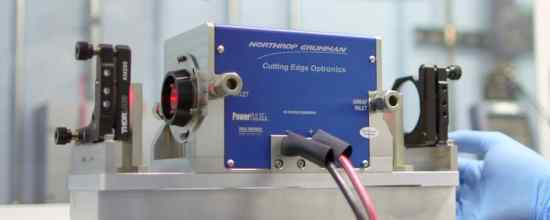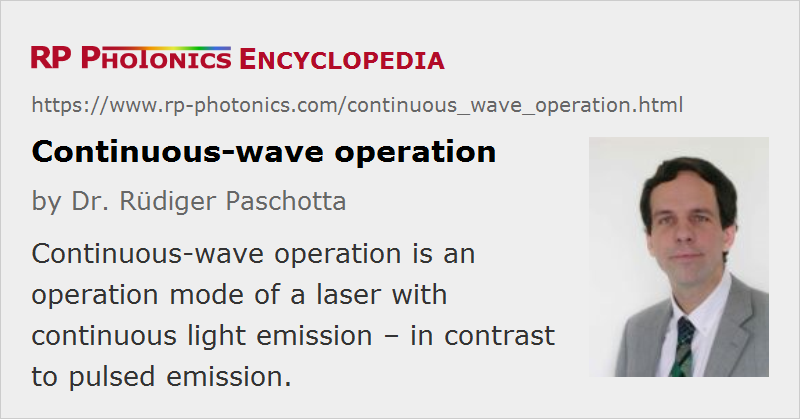Continuous-wave Operation
Definition: operation mode of a laser with continuous light emission
German: CW-Betrieb, kontinuierlicher Betrieb
How to cite the article; suggest additional literature
Author: Dr. Rüdiger Paschotta
Continuous-wave (cw) operation of a light sources means that it is continuously operated, i.e., not pulsed. The term is most frequently applied to lasers but also to gas discharge lamps, for example.
For a laser, continuous-wave operation implies that it is continuously pumped and continuously emits light. The emission can occur in a single resonator mode (→ single-frequency operation) or on multiple modes.
The first continuous-wave laser was a helium–neon laser operating at 1153 nm [1]. A version working with the now common emission wavelength of 632.8 nm was demonstrated soon after that. Later on, many other types of lasers were developed which can also be operated continuously: other gas lasers, many types of solid-state lasers (including semiconductor lasers), and dye lasers.

For many lasers with low-gain laser transitions, continuous-wave operation is difficult to achieve, while operation with pulsed pumping is easy to obtain. In some cases, continuous-wave operation is only possible with fiber lasers, but not with bulk lasers, as the fiber geometry greatly increases the gain efficiency. Some so-called self-terminating laser transitions are not suitable at all for continuous-wave operation.
The output power of a continuous-wave laser is more or less constant on longer time scales, but it can exhibit substantial power variations e.g. due to mode beating (if single-frequency operation is not achieved) and other kinds of laser noise. Various techniques for the stabilization of lasers concerning output power and/or optical frequency can be applied, often involving additional optical elements in or around the laser resonator.
Quasi-continuous-wave Operation
In continuous-wave operation, some lasers exhibit too strong heating of the gain medium. The heating can then be reduced by quasi-continuous-wave operation, where the pump power is only switched on for limited time intervals.
Continuous-wave Mode Locking
Some lasers are called continuous-wave mode-locked. This means that the laser is mode-locked, and the pulse energy (or average power) is constant, i.e. there is no Q-switched mode locking. Despite the emission of pulses, mode locking can be considered as a kind of continuous-wave operation in the sense that the resonator modes are excited with constant powers.
Questions and Comments from Users
Here you can submit questions and comments. As far as they get accepted by the author, they will appear above this paragraph together with the author’s answer. The author will decide on acceptance based on certain criteria. Essentially, the issue must be of sufficiently broad interest.
Please do not enter personal data here; we would otherwise delete it soon. (See also our privacy declaration.) If you wish to receive personal feedback or consultancy from the author, please contact him e.g. via e-mail.
By submitting the information, you give your consent to the potential publication of your inputs on our website according to our rules. (If you later retract your consent, we will delete those inputs.) As your inputs are first reviewed by the author, they may be published with some delay.
Bibliography
| [1] | A. Javan, W. R. Bennett Jr., and D. R. Herriott, “Population inversion and continuous optical maser oscillation in a gas discharge containing a He–Ne mixture”, Phys. Rev. Lett. 6 (3), 106 (1961), doi:10.1103/PhysRevLett.6.106 |
See also: modes of laser operation, quasi-continuous-wave operation, resonator modes, self-terminating laser transitions
and other articles in the category lasers
 |





If you like this page, please share the link with your friends and colleagues, e.g. via social media:
These sharing buttons are implemented in a privacy-friendly way!